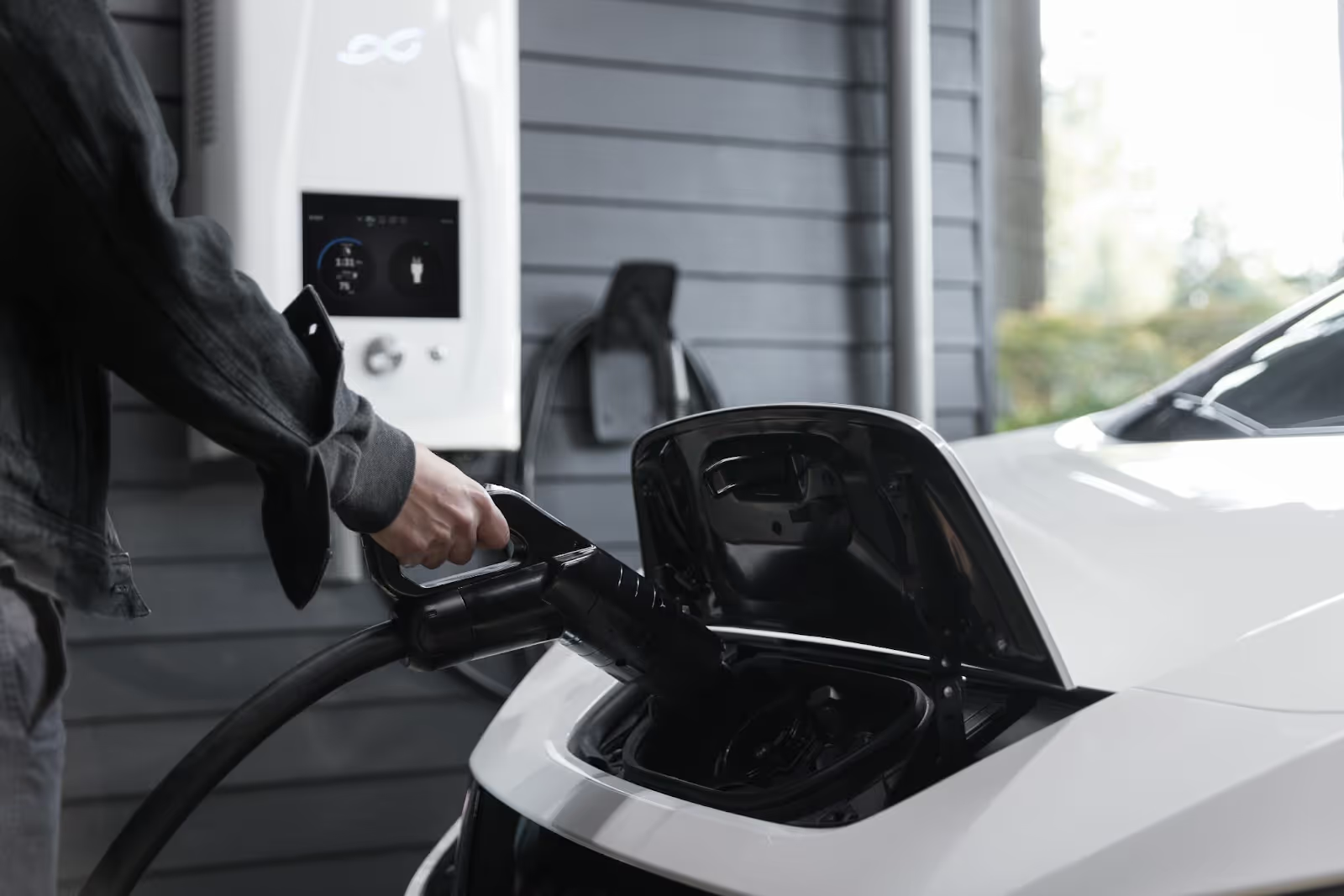Electric Vehicle Charging: A 2023 Guide
.avif)
There is currently a movement towards making EV ownership and leasing easier. In November the Prime Minister, Boris Johnson, announced that all new homes and buildings in England are now required to have charging points installed. (BBC) Whereas previously making the switch from an internal combustion engine (ICE) car to an electric one may have seemed like a daunting task, the general public are now starting to realise that it’s really not that complicated at all. This post will help explain some of the basics of how charging works, so you can focus on the fun part, driving!
EV charging – The basics
Having a home charging point tends to be the most popular choice for EV drivers, as it’s often the most convenient way to charge your EV. On average, roughly 60% of all charging is done at home.
There is some terminology when it comes to different kinds of chargers that you’ll need to get to grips with and one key term is the abbreviation kWh. Essentially, both batteries and chargers have different kilowatts (kW). Kilowatts are a unit of measuring how much energy is needed in order to power something and in turn, kilowatt per hour (kWh) means how much energy is used to power something every hour. For example, the power rating of most home charging points tends to be either 3kW, 7kW, and occasionally 22kW and the higher the kW, the faster your battery will charge (ElectricCarHome), however, there are some exceptions which we’ll get into later.
EV charging cables
Some other terms you might have heard regarding EV charging are Type 1 and Type 2. These terms relate to the types of cables and adapters you’ll need to charge your EV and the difference is that Type 1 has a 5-pin socket and is more prominent in America and Asia whereas type 2 is more popular in Europe and has a 7-pin socket (SaveMoneyCutCarbon). You’ll most likely only come across type 2 charging sockets and cables if you’re in the UK.
You can use three different types of chargers; a 3-pin plug (the kind you use in an everyday socket), a socketed charging point (where you have to bring your own cable) and a tethered charging point (where the cable is provided)(EDFEnergy). Tethered chargers tend to be more convenient (as you don’t need to attach your charging cable every time) although visually they may not be as aesthetically pleasing to some people.

How long does it take to charge an electric car?
Well, it depends on a couple of things; first, it’s dependent on what kind of battery you have in your EV. The bigger the battery, the longer it takes to charge so if your car has a long-range, it may take a bit longer to charge than other EVs. As an example, let’s say you have a Renault Zoe and you’re charging it using the most common home charger (7kWh), it typically takes around 6 hours to charge it from 0-100%. We recommend this handy guide from Pod Point, where they go into a bit more detail about how long charging can take, and here is a great resource to see how much it would take to charge specific EVs.
Additionally, your EV may only be able to charge at a certain rate, as every EV has a maximum charging speed based on the amount of kW it has. The charging time won’t decrease if you use a charge point with a higher kW, your EV will still only be able to charge at its maximum speed. For example, say your EV is capable of charging at 7kW and the charging point you’re using is capable of 22kW, you’ll still only be able to charge at 7kWh. And vice versa; the speed of charge could also depend on what kind of charging point you’re using to charge your electric car. Essentially, if the capacity of the charging point is below the capability of your vehicle, it will only go as fast as the charging point allows, even if your EV has the capacity to be charged at a faster rate, the charging point can only charge at its own capacity. (PodPoint)
One aspect that is often looked over is temperature; as batteries are sensitive to cold temperatures. This means that if it’s relatively cold, charging may take extra time and you may also notice your vehicle become slightly less charge-efficient, meaning you may have to charge your EV just a little more frequently than normal. You may notice your range is better during the summer for this very reason. (EDFEnergy)
Also, charging a battery that is already half-charged is much faster than charging an empty battery. Most EV drivers tend to top up their charge rather than letting the battery run out, so if you have the option to park somewhere that has a charging station, why not make the most of it and top up your charge? Here is a link to a resource where you can find charging stations near you.
Also, you don’t have to wait until your EV is fully charged to use it, think of it like any other electronic you use in your everyday life! (CarWow) It isn’t always necessary to charge your EV overnight either, as the batteries in EVs are designed to last for quite a while, so all you need to do is check to see if it’s necessary. (GoUltraLow)
What are the different EV charging speeds?
There are three different speeds at which an EV can be charged, rapid, fast, and slow.
You have heard of rapid chargers before; they are only suited for EVs that have the capability to be charged using a rapid charger, so it’s best to check beforehand if your EV is compatible. Fast chargers will fall into one of two categories, either 7kW or 22kW and these are the ones you’ll see most often when you’re out and about in supermarkets or car parks, Finally, slow chargers are usually what will be installed in your home as these are great to use for an overnight charge. (EDFEnergy)

Home EV charging points
As previously mentioned, your home charging point will most likely be a slow charger with a kW of either 3.6kW or 7kW, depending on what kind of charger is compatible with the battery you have in your EV.
How much does it cost to charge an electric car?
On average, the cost of fully charging an electric car at home is about £15.10 (based on a battery size of 54kWh at a rate of 28p/kWh). Usually, EV drivers will tend to do most of their charging at home as it tends to be more convenient and although public charge points can vary in price, it is often cheaper to charge at home.
EV charging point installation
So, how does the installation of one of these charging points actually work? If you sign up with loveelectric, Pod Point will install a home charger in a suitable place, typically somewhere like on an exterior wall, your garage, or in your driveway and it will be connected to your mains electricity. The installation process itself won’t actually take that long, Pod Point estimates it to take about 3 hours until it’s ready to use.
Egg Charging
Egg’s cracking smart chargers allow electric car drivers to spread the cost of installation and the charger itself for only £24.50 per month. They’ve brought everything we love about smart charging into one tight shell.
We love their solution so much that we’ve partnered with them to offer loveelectric customers a crackin’ deal. Opt for one of their smart chargers and we’ll cover the £108 cost of Egg Plus - Egg’s premium service offering replace-or-repair protection and access to the smart charging app.
That’s three years of worry-free, low-cost charging for stress-free, all-electric motoring.
On their basic package, you’ll get a fully installed charger. Egg Plus, their premium subscription, gives you access to the Egg Plus smart charging app, where drivers can set their preferences, plug in and forget – the app handles the rest.
This deal in short:
🍳 Fully installed home electric car charger
🍳 Flexible: pay up front or spread the cost
🍳 Utilise low-tariff windows with smart charging
We’ll cover the £108 cost for 3 years of Egg Plus - complete peace of mind for your hassle-free charger.
💚 Cover: “No fuss”, repair-or-replace promise
💚 Access: Dedicated smart charge EV app
💚 Feel good: Our commission goes to charity
Get your affordable smart home charger here.
How much does installation cost?
If you sign up with loveelectric, our partner PodPoint will install a charging point that would work best for the electric car you have chosen to lease. The price will depend on what kind of EV you have, what kind of charger (tethered or untethered) you want and the charging speed. Here’s a link to the PodPoint website where you can input your specifications to see how much it would cost you!
You may also have heard that the government announced it will end the Electric Vehicle Homecharging Scheme (EVHS) at the end of March 2022. This government grant allowed a £350 discount on all home charging installations. If you want to ensure you get that discount, we recommend making sure you place an order with us before the end of February so we can ensure you’ll qualify for that discount.

FAQs
Can I use a 3-pin plug instead of a charge point?
Yes, however, you may end up paying more by using a typical 3 pin plug charger. This is because they are far less efficient than a charge point, on average they take around 3 times longer than using a charge point. Also, if your vehicle has a very large battery, it may not even manage to fully charge your EV, even if you leave it overnight. Therefore, going with a charge point instead is a better option. So, while it’s definitely possible to use a 3-pin plug charger instead of a charging point, it’s far less convenient.
Additionally, using a dedicated home charger is more efficient as once your battery has been fully charged, your home charger will automatically switch off which will save on your energy bill. (PodPoint)
How can I make charging my EV cheaper?
Pod Point also offers an option to charge your EV remotely using Solo 3, meaning you can turn on or off your charging without needing to physically remove the charger from your EV. Using Solo, you can also select when you’d like to charge your EV, meaning if you chose to charge during off-peak hours you could save almost up to 3 quarters of the cost of charging if it’s done during those hours. Along with this, you can also set up a schedule of when you’d like to charge your vehicle, so that way you don’t even need to remember to charge it!
But what happens if I run out of charge?
One of the main reasons people cite for their hesitations to make the switch is due to the common misconception that there aren’t many charging stations in the UK, whereas in actuality, there are thousands. Today, there are a dozen apps that can show you available charging locations so you can plan out your journey ahead of time, or if you realise that you’re running low on your charge, you can quickly check where the closest one is. Check out the Pod Point charging app, it’s free, really easy to use and they have a map of over 1,700 public charging stations across the United Kingdom.




